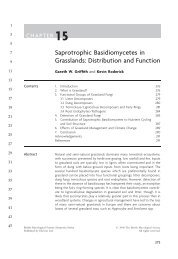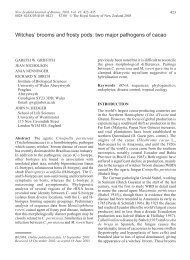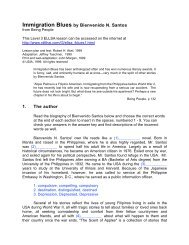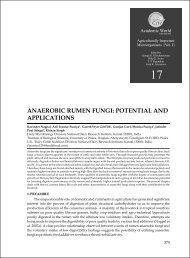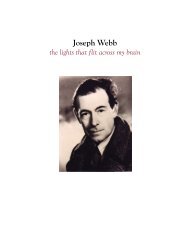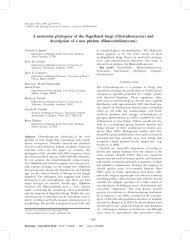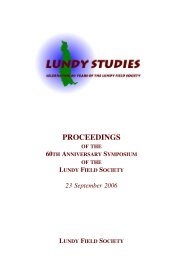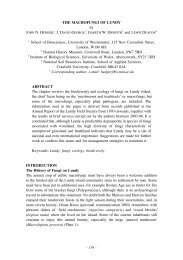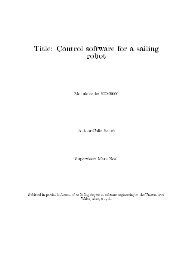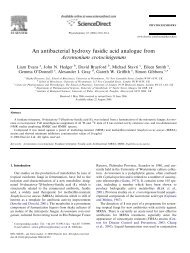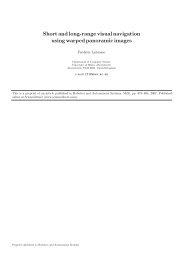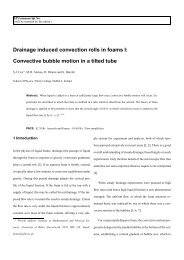LUNDY FUNGI: FURTHER SURVEYS 2004-2008 - Users Site
LUNDY FUNGI: FURTHER SURVEYS 2004-2008 - Users Site
LUNDY FUNGI: FURTHER SURVEYS 2004-2008 - Users Site
Create successful ePaper yourself
Turn your PDF publications into a flip-book with our unique Google optimized e-Paper software.
- 21 -<br />
Journal of the Lundy Field Society, 2, 2010<br />
<strong>LUNDY</strong> <strong>FUNGI</strong>: <strong>FURTHER</strong> <strong>SURVEYS</strong> <strong>2004</strong>-<strong>2008</strong><br />
by<br />
JOHN N. HEDGER 1 , J. DAVID GEORGE 2 , GARETH W. GRIFFITH 3 , DILUKA PEIRIS 1<br />
1 School of Life Sciences, University of Westminster,<br />
115 New Cavendish Street, London, W1M 8JS<br />
2 Natural History Museum, Cromwell Road, London, SW7 5BD<br />
3 Institute of Biological Environmental and Rural Sciences,<br />
University of Aberystwyth, SY23 3DD<br />
Corresponding author, e-mail: hedgerj@wmin.ac.uk<br />
ABSTRACT<br />
The results of four five-day field surveys of fungi carried out<br />
yearly on Lundy from <strong>2004</strong>-08 are reported and the results<br />
compared with the previous survey by ourselves in 2003 and<br />
to records made prior to 2003 by members of the LFS. 240<br />
taxa were identified of which 159 appear to be new records<br />
for the island. Seasonal distribution, habitat and resource<br />
preferences are discussed.<br />
Keywords: Fungi, ecology, biodiversity, conservation, grassland<br />
INTRODUCTION<br />
Hedger & George (<strong>2004</strong>) published a list of 108 taxa of fungi found on Lundy during a<br />
five-day survey carried out in October 2003. They also included in this paper the records<br />
of 95 species of fungi made from 1970 onwards, mostly abstracted from the Annual<br />
Reports of the Lundy Field Society, and found that their own survey had added 70<br />
additional records, giving a total of 156 taxa. They concluded that further surveys would<br />
undoubtedly add to the database, especially since the autumn of 2003 had been<br />
exceptionally dry, and as a consequence the fruiting of the larger fleshy fungi on Lundy,<br />
especially the grassland species, had been very poor, resulting in under-recording.<br />
Further five-day surveys were therefore carried out each year from <strong>2004</strong>-08, three in<br />
the autumn, 08-12 November <strong>2004</strong>, 04-09 November 2007, 03-11 November <strong>2008</strong>, one<br />
in winter, 23-27 January 2006 and one in spring, 09-16 April 2005. The preliminary<br />
results are presented here. As discussed in our previous accounts of the fungi on Lundy<br />
(Hedger & George, <strong>2004</strong>; Hedger et al., 2007) the results must be viewed as giving only<br />
a partial picture of the status of fungi on Lundy, firstly because of the briefness of the<br />
visits in each year, and the fact that fruiting bodies, which have unpredictable weatherdependent<br />
fruiting timing, were the basis of the surveys. Assessment of seasonal and<br />
habitat distribution of species of fungi by fruit bodies should always be regarded as an<br />
approximation of the distribution of the mycelia which formed them (Feest, 1999).<br />
However, it remains the only practical approach and the surveys reported here have<br />
yielded useful information about the fungi on Lundy that will provide a basis for our<br />
future studies.
Journal of the Lundy Field Society, 2, 2010<br />
METHODS<br />
Field Surveys<br />
The field surveys used the method outlined in Hedger & George (<strong>2004</strong>) and involved<br />
collecting and photographing fungi along different routes over the island each day,<br />
followed by detailed examination of the fresh material in the evenings using a<br />
microscope and then overnight drying of voucher specimens in envelopes for storage in<br />
a mycological herbarium held in the University of Westminster. Each fungus sample<br />
was given a collection number, the site identified by GPS to a 10-figure grid reference<br />
and, where possible, the fungus was photographed in its natural environment. The<br />
habitat was noted and in the database broadly classified into short turf, tall grassland,<br />
wet grassland with Molinia caerulea and rushes, Calluna heath, tall Bracken and<br />
woodland, the latter including Blackthorn, Rhododendron and Gorse thickets. The<br />
substratum on which the fungus was fruiting/ growing was also recorded and classified<br />
e.g on soil, in grass, on herbivore dung, on dead wood, on leaf litter. The life strategies<br />
of the fungi were assessed as saprotrophic - clearly associated with decomposition of<br />
dung, litter or wood; parasitic - growing on living plants as pathogens; or mycorrhizal -<br />
associated with living roots of shrubs and trees.<br />
As part of the November <strong>2004</strong> survey a more detailed examination of fruit body<br />
distribution of grassland species of macrofungi was carried out on 10 November within<br />
a 180 x 60 m quadrat (10800m 2 ) laid out in the grassland bounded by the stones marking<br />
the edges of the south-western end of the Airfield. Line transects at 2 m intervals were<br />
then walked and the position of each fruit body recorded using a Trimble ProXR GPS<br />
system with accuracy down to 50cm and data entered on a laptop as Excel files. In<br />
addition a 50 x 50 m quadrat was laid out in Middle Park near the Mangonel Battery<br />
and divided into line transects laid out at 2 m intervals which were walked and fruit<br />
bodies recorded. Surveys were repeated at both sites in 2007 and <strong>2008</strong> by walking along<br />
similar line transects but without Trimble ProXR GPS positioning.<br />
Identification of Taxa<br />
The identification of the taxa of fungi remains tentative in some cases, and may require<br />
revision once the voucher material has been examined by specialists.<br />
RESULTS<br />
Field Survey<br />
The summarised results for the five surveys, November <strong>2004</strong>, April 2005, January 2006,<br />
November 2007, November <strong>2008</strong> are given in the Table in the Appendix (page 36). The<br />
first column shows the taxa recorded, an asterisk indicating a species not recorded in the<br />
2003 survey, or by the previous surveys summarized in Hedger & George (<strong>2004</strong>). The<br />
taxa have been divided up into groupings in an artificial ‘field-orientated’ manner, into<br />
‘microfungi’ and ‘macrofungi’, on the basis of the size of the fruit bodies. In addition,<br />
popular, but not natural, names for some of the divisions and orders of fungi are used,<br />
rather than the more complex ‘natural’ groupings accepted in current treatments of UK<br />
- 22 -
- 23 -<br />
Journal of the Lundy Field Society, 2, 2010<br />
fungal biodiversity (see www.fieldmycology.net/FRDBI/FRDBI.asp), for example the<br />
‘Aphyllophorales’ (Bracket fungi). These terms are used in many of the current popular<br />
fungal field guides (e.g. Phillips, 2006). This approach was employed in the 2003 survey<br />
(Hedger & George, <strong>2004</strong>), and has the advantage of making comparisons easier. In<br />
addition, records of fruiting bodies of the Myxomycetes, (Slime Fungi) are included in<br />
the Table, although these organisms are not true fungi (Ing, 1999). Fungal taxonomy is<br />
in a constant state of flux. It will be necessary in the future to revise past records from<br />
Lundy (Hedger & George, <strong>2004</strong>) and those presented in this paper, to incorporate<br />
current interpretations of taxa, e.g. Legon & Henrici (2005) for the Basidiomycota. The<br />
sources for the names used in the Table are as follows: Microfungi: Ellis & Ellis (1997),<br />
Macrofungi: Ascomycota, Breitenbach & Kranzlin (1981), Jordan (1988), Ellis & Ellis<br />
(1997), Spooner & Nauta (1997); Clavariaceae, Henrici (1997), Phillips (2006);<br />
Polyporaceae, Breitenbach & Kranzlin (1986), Jordan (1988); Agaricales, Moser (1983)<br />
with updates from Courtecuisse & Duhem (1995), Phillips (2006); Gasteromycetales,<br />
Jordan (1988), Breitenbach & Kranzlin (1986); Heterobasidiomycetales, Breitenbach &<br />
Kranzlin (1986), Phillips (2006); Myxomycetes, (Ing, 1999).<br />
The Collection number in the Table refers to the voucher specimen, and the following<br />
column the site where this collection was made (the notation nc means no collection<br />
was made). Records of the fungi from the five surveys are noted in the last five columns<br />
of the Table. In the case of fungi recorded on more than one survey the substrate/host,<br />
the Collection number and site refer only to the first collection. Details of the later<br />
records are omitted in order to reduce the complexity of the Table.<br />
Seasonality of Records<br />
The five surveys recorded a total of 240 taxa, of which 159 were new records for Lundy<br />
compared to Hedger & George (<strong>2004</strong>), who published records of 156 taxa, giving a<br />
current total for Lundy of 315. This is a lower total than the estimate of 358 given by<br />
Hedger et al. (2007), the reduction being due to revision of species identifications.<br />
Predictably some of the new records were of microfungi (37), easily overlooked bv the<br />
non-specialist in brief visits to the island, but most were new records of macrofungi,<br />
including some common taxa of large size, such as the agaric Macrolepiota rhacodes<br />
(Shaggy Parasol Mushroom), recorded near the Castle in <strong>2004</strong>, emphasizing the underrecorded<br />
status of the Lundy mycoflora. The Table shows that the timing of the<br />
collecting visit had an effect on the distribution of the records. The three November<br />
visits (<strong>2004</strong>, 2007, <strong>2008</strong>) produced many records of macrofungi, especially agarics,<br />
which fruit in the late summer/autumn. However, the records for the visit in January<br />
2006 also included many of these fungi, for example six species of Waxcaps (Hygrocybe),<br />
possibly because the mild oceanic climate and higher winter soil temperatures on Lundy<br />
allowed these ‘autumn’ fungi to continue fruiting, although the abundance of fruit<br />
bodies and numbers of species was much lower than in November. One well-known<br />
‘winter’ agaric was found on this visit, Flammulina velutipes, the frost resistant ‘Winter<br />
Mushroom’, on dead Gorse behind the Brambles cottages.<br />
In contrast, in Spring (April 2005), only seven agaric species were recorded in total,<br />
most of them common grassland species such as Coprinus plicatilis, Conocybe subovalis and
Journal of the Lundy Field Society, 2, 2010<br />
Panaeolus foenisecii which probably only stop fruiting on Lundy during summer<br />
droughts. No truly spring-fruiting agarics were found, but are to be expected, for<br />
example the large and conspicuous Calocybe gambosa (St George’s Mushroom) that<br />
fruits in late April/May and was recorded from the New Barn by Montagu (1973). The<br />
low number of macrofungi recorded was probably caused by the dry conditions in<br />
April 2005. An examination of the Table shows that the majority of macrofungi<br />
recorded during the April 2005 survey had hard or persistent fruit bodies, mostly wood<br />
decomposers such as Phellinus ferrugineus (Plate 1a), Hymenochaete corrugata, Daldinea<br />
concentrica Xylaria hypoxylon (Plate 1b) and X. polymorpha. New records from April<br />
2005 included pathogenic microfungi on plants. Some of the eight species of Rusts<br />
(Uredinales) recorded sporulate on their hosts in the spring, for example the bright<br />
yellow aecidia of Puccinia caricina (Plate 1c) on leaves of the Nettle, (Urtica dioica) and<br />
the dark telutosori of Uromyces muscari on leaves of the Bluebell (Hyacinthoides nonscripta).<br />
Another example is the Anther Smut (Ustilago violacea), surprsingly<br />
unrecorded before <strong>2004</strong>, but finally found on flowers of the Red Campion (Silene rubra)<br />
in Millcombe Valley on a day visit in May 2005 and was even more abundant in the<br />
same location in June 2009 (Hedger, unpublished data). Also in Millcombe, the<br />
yellow spots caused by Ramularia ari (Plate 1d) were common on the leaves of<br />
Lords-and-Ladies (Arum maculatum).<br />
The Table also shows a preponderance of records of saprotrophic microfungi and<br />
the smaller macrofungi in the discomycetes and pyrenomycetes for April 2005 and<br />
January 2006. This may be an artifact related to collecting effort, rather than<br />
seasonality, since the absence of macrofungi meant that attention could be paid to<br />
likely locations for these minute fungi, using Ellis & Ellis (1997) to confirm identities.<br />
However, winter and spring would be times when the water content of the litter would<br />
be high enough to allow these fungi to sporulate, for example the delicate white cups<br />
of the discomycete Dasycyphus virgineus (Plate 1e) on the litter of Heather (Calluna<br />
vulgaris). A good example of a rich habitat for these litter decomposer fungi is the Soft<br />
Rush (Juncus effusus) whose clumps were especially productive in April 2005 and<br />
January 2006, with records of the minute but beautiful Unguicularia costata,<br />
Myriosclerotinia curreyana, Mollisea juncina, Dasycyphus apalus, Dasycyphus rehmii<br />
(discomycetes), Leptosphaeria juncini (pyrenomycetes) Stagonospora innumerosa,<br />
Conoplea fusca and Cercosporella juncini (hyphomycetes).<br />
Habitat and Resource Preferences<br />
Hedger & George (<strong>2004</strong>) and Hedger et al. (2007) reviewed the habitat and resource<br />
preferences of fungi on Lundy. There is only a very small area of the island with tree<br />
cover, comprising Millcombe Valley and tiny pockets of trees along the East Sideland<br />
up to the Quarries (Hubbard, 1971). The major habitat is grassland and heath, although<br />
the plant communities vary considerably in species composition between the east and<br />
West Sideland, the plateau north and south, the farm and marshy areas such as<br />
Pondsbury, each of which has a distinct species assemblage of fungi (Hedger et al.,<br />
2007). The present results confirm this picture but have expanded the numbers of taxa<br />
recorded for each plant community.<br />
- 24 -
Journal of the Lundy Field Society, 2, 2010<br />
Woodland<br />
Fungi found in woodland are likely to be either mycorrhizal partners of the trees or leaf<br />
litter and wood decomposers. Some wood decomposers have been recorded at the same<br />
site since the Lundy fungus survey began and will persist until the tree or stump has been<br />
completely decomposed, for example Phellinus ferrugineus (Plate 1a) on the Rhododendron<br />
stumps near The Ugly and Xylaria hypoxylon (Plate 1b) on the pile of Ash logs near the<br />
Walled Garden in Millcombe Valley. The Table does however show that the number of<br />
decomposer fungi recorded has been increased considerably by the surveys, mostly species<br />
of Polyporaceae, including some unusual records. Asterostroma medium (Plate 2a), a rare<br />
resupinate fungus containing stellate setae was found on decaying Turkey Oak (Quercus<br />
cerris) branches in Quarter Wall Copse in November <strong>2008</strong>. The strikingly orange and<br />
uncommon Hymenochaete cinnamomea (Plate 2b) was recorded from Rhododendron stumps<br />
near The Ugly also in November <strong>2008</strong>. It will be interesting to see if the temporary increase<br />
in woody resources for decomposers afforded by the Rhododendron clearances over the<br />
next few years will further increase the biodiversity of lignicolous fungi. Unusual hosts for<br />
some lignicolous fungi on Lundy were noted by Hedger & George (<strong>2004</strong>) for a number of<br />
species, for example Phellinus tuberculosus on Gorse (Ulex europaea). Further evidence for<br />
this trend is the Porcelain fungus Oudemansiella mucida, (Plate 2d), recorded on branches<br />
of the Beech (Fagus sylvaticus) in Quarter Wall Copse in November 2007, but noted during<br />
the November <strong>2008</strong> survey to have spread into an adjacent Turkey Oak.<br />
Hedger & George (<strong>2004</strong>) and Hedger et al. (2007) postulated that future surveys would<br />
increase the number of records of mycorrhizal species of fungi from the wooded areas,<br />
especially in the agaric families Russulaceae and Cortinariaceae and in the orders Boletales<br />
and Sclerodermatales. So far this has not happened, with the exception of two more species<br />
of Russula, R. cyanoxantha (Plate 2c) and R. foetens recorded in November <strong>2008</strong> under Holm<br />
Oak (Quercus ilex) in Millcombe Valley (Appendix). Either Lundy is depauperate in these<br />
fungi or they are fruiting earlier, in July-September, and so were absent during the surveys.<br />
Grassland and Heath<br />
Hedger et al. (2007) followed Hubbard (1997) in dividing this habitat into four types: 1)<br />
Short Turf Grassland, maintained by intensive grazing (e.g. Middle Park, Acklands<br />
Moor, Southwest Field, the Airfield, Castle Hill); 2) Tall Grassland with Molinia<br />
caerulea, Juncus effusus and Bracken (Pteridium aquilinum) (e.g. the area between Quarter<br />
Wall and Halfway Wall); 3) fenced-off improved grassland around the farm; 4) Calluna<br />
vulgaris-dominated heath north of Threequarter Wall. Hedger & George (<strong>2004</strong>) pointed<br />
out that the fungi in these habitats are either directly associated with the plants as<br />
pathogens, decomposers and mycorrhizal partners, or are coprophilous species, growing<br />
on dung, for example Coprobia granulata (Plate 1f), whose bright orange apothecia are<br />
common on the dung of Sheep, Pony and Sika Deer throughout the island.<br />
Short Turf Grassland<br />
The most diverse community of fungi on Lundy is associated with the unimproved short<br />
turf grassland and the data presented in the Table in the Appendix show that the number<br />
of species recorded from this habitat has been increased considerably by the surveys.<br />
- 25 -
- 26 -<br />
Journal of the Lundy Field Society, 2, 2010<br />
Plate 1: 1a Phellinus ferrugineus (Orange Pore Crust), ×1, fb on Rhododendron stump, The<br />
Ugly; 1b Xylaria hypoxylon (Candle Snuff Fungus), ×2.5, fb on Fraxinus excelsior (Ash)<br />
log, Millcombe Valley; 1c Puccinia caricina (Nettle Rust), ×2, aecidia on Urtica dioica<br />
(Nettle), The Quarries; 1d Ramularia ari, ×2.5, causing necrotic patches on leaves of<br />
Arum maculatum (Cuckoo Pint), Millcombe Valley; 1e Dasycyphus virgineus, ×3, apothecia<br />
on dead Calluna vulgaris (Heather) stems, The Quarries; 1f Coprobia granulata, ×2,<br />
apothecia on Sheep dung, The Airfield. (fb=fruit body)<br />
1a<br />
1c 1d<br />
1e<br />
1b<br />
1f
Journal of the Lundy Field Society, 2, 2010<br />
Plate 2: 2a Asterostroma medium, ×1, fb on fallen branch of Quercus cerris (Turkey Oak),<br />
Quarter Wall Copse; 2b Hymenochaete cinnamomea, ×1, fb on Rhododendron stump, The<br />
Ugly; 2c Russula cyanoxantha (Charcoal Burner), ×1, fb under Quercus ilex (Holm Oak),<br />
Millcombe Valley; 2d Oudemansiella mucida (Porcelain Agaric), ×2, fbs on dead branch<br />
of Quercus cerris (Turkey Oak), Quarter Wall Copse; 2e Hygrocybe virginea var. fuscescens<br />
(Snowy Waxcap), ×1.5, underside of fb in grass, Golden Well; 2f Hygrocybe virginea, var<br />
unknown-closest to fuscescens, ×1.5, underside of fb in grass, Golden Well; 2g Hygrocybe<br />
psittacina (Parrot Waxcap), ×2, fb in short turf, The Hospital. (fb=fruit body)<br />
2a 2b<br />
2c 2d<br />
2e 2f 2g<br />
- 27 -
3g<br />
- 28 -<br />
Journal of the Lundy Field Society, 2, 2010<br />
Plate 3: 3a Hygrocybe punicea (Crimson Waxcap), ×0.5, fbs in long grass, The Airfield;<br />
3b Psilocybe semilanceata, (Liberty Cap), ×2, fbs in short turf, Lighthouse Field;<br />
3c Clavulinopsis corniculata (Meadow Coral), ×2, fbs in short turf near Quarter<br />
Wall Cottages; 3d Clavulinopsis helvola (Golden Spindles), ×2.5, fbs in short turf at side<br />
of central path above Gannets Combe; 3e Geoglossum umbratile (Earth Tongue), ×2, fbs<br />
in short turf, west end of Quarter Wall; 3f Coprinus plicatilis (Pleated Inkcap), ×2.5, fb in<br />
long turf, Croquet Lawn below Tavern; 3g Hygrocybe chlorophana (Yellow Waxcap),<br />
×1.5, fbs in long grass, East Coast path near Brazen Ward; 3h Entoloma turci, fbs ×0.75,<br />
in tall grass above Benjamin’s Chair. (fb=fruit body)<br />
3a 3b 3c<br />
3d 3e<br />
3f<br />
3h
Journal of the Lundy Field Society, 2, 2010<br />
Plate 4: 4a Russula cf. nana, ×0.75, fb under Molinia caerulea/Bog Myrtle (Myrica gale) at<br />
side of Central Path N. of Quarter Wall; 4b Lactarius cf. lacunarum, ×1, fb under Molinia<br />
caerulea/Bog Myrtle (Myrica gale) at side of central path N. of Quarter Wall; 4c Cortinarius<br />
cf. phaeopygmaeus, ×3, fbs in short turf/Thyme (Thymus communis), Quarter Wall<br />
Cottages; 4d Hygrocybe cf. lacmus, ×1.5, fbs on bare peat in short Heather (Calluna vulgaris),<br />
near John O’Groats House; 4e Clavaria argillacea (Moor Club), ×3, fbs on bare peat in short<br />
Heather (Calluna vulgaris), near John O’Groats House; 4f Galerina laevis, ×3, fbs in<br />
Leucobryum moss/bare peat in Rhododendron clearance site, The Ugly. (fb=fruit body)<br />
4a 4b<br />
4c<br />
4e<br />
- 29 -<br />
4d<br />
4f
- 30 -<br />
Journal of the Lundy Field Society, 2, 2010<br />
Recent published work (Griffith et al., 2002, <strong>2004</strong>, 2006; Griffith & Roderick, 2007;<br />
Newton et al., 2003) has emphasised the importance of the diversity of species of higher<br />
fungi as indicators of grassland habitat quality. These ‘indicator species’ include members<br />
of the agaric genera Entoloma, (Pink Gills) for example E.turci (Plate 3h) and Hygrocybe,<br />
(Waxcaps) for example H. punicea (Plate 3a), H. chlorophana (Plate 3g), H . Psittacina (Plate<br />
2g), H. virginea var fuscescens (Plates 2e & f). Other indicator fungi include species in the<br />
genus Clavulinopsis (family Clavariaceae, Coral Fungi or Fairy Clubs) ,for example<br />
Clavulinopsis helvola (Plate 3d), C. corniculata (Plate 3c) and the genera Geoglossum,<br />
Trichoglossum and Microglossum (Family Geoglossaceae, Earth Tongues), for example<br />
Geoglossum umbratile (Plate 3e). <strong>Site</strong>s in the UK have been ranked according to scores<br />
based on the numbers of these indicator species, the CHEGD system (Clavariaceae,<br />
Hygrocybe, Geoglossaceae, Entoloma, Dermoloma) described in Rotheroe et al. (1996,<br />
2001), Griffith et al. (<strong>2004</strong>). Hedger & George (<strong>2004</strong>) in reporting the results of the first<br />
detailed survey of fungi on Lundy in November 2003, paradoxically listed very few of<br />
these indicator species, but this was due to the exceptionally dry autumn that year. The<br />
surveys in wetter Novembers in <strong>2004</strong>, 2007, <strong>2008</strong> (Appendix) have generated an ‘indicator<br />
species’ total of 5 for Clavariaceae (all Clavulinopsis species, excluding Clavaria argillacea,<br />
associated with Calluna heath), 22 for Hygrocybe (including the three varieties of H.<br />
virginea, but excluding H.cf. lacmus which is associated with Calluna heath), 8 for Entoloma,<br />
5 for Geoglossaceae, (3 for Geoglossum and 1 each for Trichoglossum and Microglossum), 1<br />
for Dermoloma. The record of Microglossum viride (Green Earth Tongue) in <strong>2004</strong> from the<br />
Airfield is of special interest since this is an important ‘indicator species’ on the CHEGD<br />
system (Griffith et al., <strong>2004</strong>). Hedger et al. (2007) and Haw (2009) emphasized that these<br />
findings confirm the national conservation status of Lundy grassland.<br />
During the survey carried out in November <strong>2004</strong> a more detailed study of the fungi<br />
associated with short turf was carried out on a 180 x 60 m quadrat (10,800 m 2 ) on the<br />
Airfield using a GPS system to measure the positions of fruit bodies (see Methods). The<br />
results are shown in Figure 1 and Table 1. A total of 1264 fruit bodies were recorded (0.11<br />
per m 2 ). The abundance of the fruiting of ‘indicator taxa’is clear: 14 species of Hygrocybe,<br />
1 species of Entoloma, 1 species of Dermoloma, 4 species of Clavariaceae and 2 species of<br />
Geoglossaceae were recorded. In addition two prominent rings of fruit bodies of the<br />
Wood Blewit (Lepista nuda) were mapped in the north corner (see Figure 1). A resurvey<br />
was carried out by walking line transects across the site (see Methods) in November 2007<br />
and <strong>2008</strong>. Although the airfield had obviously been mowed regularly, the grass height had<br />
increased considerably by 2007 and by <strong>2008</strong> it was covered by deep matted turf. Only a<br />
few of the ‘indicator species’ present in <strong>2004</strong> were found, and all in very low numbers<br />
(Hygrocybe virginea var. virginea, H. psittacina in 2007; H. punicea, H. russocoriacea in <strong>2008</strong>).<br />
There were no Lepista nuda at the sites of the rings recorded in <strong>2004</strong>. Most of the agarics<br />
found were Panaeolus spp., Psilocybe semilanceata (Liberty Cap Plate 3b), Agaricus arvensis,<br />
and Stropharia aeruginosa, all coprophilous or characteristic of dung-enriched soil and all<br />
of which were present in the <strong>2004</strong> survey, but not mapped. Middle Park east of the<br />
Mangonel Battery was also surveyed by line transects in <strong>2004</strong> and was found to be almost<br />
as diverse for Hygrocybe and Clavariaceae species as the Airfield. Resurveys at the same<br />
site by line transects in 2007 and <strong>2008</strong> found no ‘indicator species’.
Journal of the Lundy Field Society, 2, 2010<br />
Figure 1: Map of positions of fruit bodies determined by a GPS survey of grassland<br />
species of macrofungi in a 180x 60 m quadrat on the Airfield, 10th November <strong>2004</strong><br />
Details of the survey are given in the methods section of the paper. Accuracy was to 50cm.<br />
Only positions of species recorded as four or more fruit bodies in the survey are included.<br />
For the full data set see Table 1. In the key H. represents the genus Hygrocybe (Wax Caps).<br />
Where taxa were recorded at a lower frequency (1-3 fruit bodies) they are shown at family<br />
or generic level, viz ‘Clavariaceae’, where four species were found Clavaria fumosa<br />
Clavulinopsis corniculata, C. fusiformis, C. helvola; ‘Geoglossaceae’, where three species were<br />
found Geoglossum glutinosum, Trichoglossum hirsutum, Microglossum olivaceum; ‘other<br />
Hygrocybe spp.’ were H. ceracea, H. flavipes, H. insipida,, H. quieta, H. reidii.; Entoloma spp.<br />
were H. conferendum, H. asprellum.<br />
10 m<br />
N<br />
- 31 -<br />
Clavariaceae spp.<br />
Entoloma spp.<br />
Geoglossaceae<br />
H. chlorophana<br />
H. coccinea<br />
H. Conica<br />
H. Laeta<br />
H. pratensis<br />
H. psittacina<br />
H. punicea<br />
H. Russocoriaceae<br />
H. Virginea<br />
Lepista saeva<br />
Other Hygrocybe spp.<br />
Boundary stones
- 32 -<br />
Journal of the Lundy Field Society, 2, 2010<br />
Table 1. Number of fruit bodies of macrofungi recorded from a 180 x 60m quadrat on<br />
the Airfield, 10 November <strong>2004</strong><br />
Species Number of fruit bodies<br />
Hygrocybe ceracea 38<br />
H .chlorophana 244<br />
H. coccinea 133<br />
H. conica 111<br />
H. flavipes 3<br />
H. insipida 3<br />
H. laeta 210<br />
H. pratensis 111<br />
H. psittacina 36<br />
H. punicea 96<br />
H. quieta 1<br />
H. reidi 2<br />
H. russocoriacea 154<br />
H. virginea 66<br />
Clavulinopsis corniculata 10<br />
Clavulinopsis fusiformis 9<br />
Clavulinopsis helvola 5<br />
Clavulinopsis fumosa 4<br />
Geoglossum glutinosum 2<br />
Trichoglossum hirsutum 3<br />
Microglossum olivaceum 1<br />
Entoloma conferendum 2<br />
Dermoloma sp. 1<br />
Lepista nuda 19<br />
Total number of fruit bodies 1264<br />
Number per m 2 0.11<br />
The apparent loss of ‘indicator species’ diversity in these sites is probably related to the<br />
reduction in rabbit grazing caused by the Myxomatosis outbreak in 2006. Both the Airfield,<br />
Middle Park, and other previously short turf areas of the island such as the South Field had<br />
by 2007 changed to tall rank grass. In contrast, in both November 2007 and <strong>2008</strong>, areas of<br />
the island that continued to be grazed down to short turf still had a high diversity of<br />
‘indicator species’. An example was the pony-grazed area at the back of Quarter Wall<br />
Cottages and around the Hospital where eight species of Hygrocybe, (H. chlorophana, H.<br />
coccinea, H. ceracea, H. conica, H. insipida, H. persistens, H. russocoriacea, and H. pratensis) and<br />
three species of Clavariaceae (Clavulinopsis helvola, C. fusiformis, C. corniculata) were recorded<br />
in November 2007, and almost the same number in <strong>2008</strong>. Other similar ‘hot spots’ of grazed<br />
turf in <strong>2008</strong> were the west end of Quarter Wall and around the end of the central path above<br />
the North Light where Geoglossum species and Trichoglossum hirsutum were recorded.. In<br />
addition, sections of the path along the west side and south end of the island where turf<br />
height is reduced by footfall also produced fruit bodies of Hygrocybe and Entoloma species,<br />
especially H. insipida, H. chlorophana and H. russocoriacea and Entoloma turci, E. conferendeum -<br />
the latter species seemed to be the ‘indicator taxon’ least affected by grass height and was the<br />
only Entoloma species common in the tall grass areas in the 2007 and <strong>2008</strong> surveys.
Journal of the Lundy Field Society, 2, 2010<br />
The explanation of these changes may simply be that the mats of tall vegetation now<br />
built up over many previous rabbit-grazed short turf areas inhibit fruiting of the fungi,<br />
either by reducing light penetration, which is needed to initiate sporulation in some<br />
higher fungi (Stamets & Chilton, 1983), or that the higher and more constant humidity<br />
at soil level has a similar effect. Many of the short turf species which have small fruit<br />
bodies may simply be hidden in the turf mat, for example agarics such as Mycena aetites,<br />
Mycenella bryophila, Rickenella fibula and Coprinus plicatilis (Plate 3f). A more worrying<br />
hypothesis is that the changes of grazing are directly affecting the mycelia of these fungi<br />
in the soil, either by altering nutrient status or by changing in the plant diversity and with<br />
it the fungal diversity.<br />
Tall Grassland<br />
The <strong>2004</strong> list of fungi from this habitat was extended by the surveys. Most of the<br />
macrofungi continued to be a limited range of decomposer species characteristic of acid<br />
litter under Bracken and Molinia, for example species of Mycena and the False Chanterelle<br />
(Hygrophoropsis aurantiacus), but a number of interesting species of Collybia and Clitocybe<br />
were added (see Appendix), the largest being Clitocybe nebularis (3-8 cm diameter cap), a<br />
woodland species in most of Britain, found growing in 2-3 m diameter rings in matted<br />
Rushes and Bracken, abundant in <strong>2004</strong>, but not seen in subsequent surveys.<br />
Unexpected records from this habitat included genera of agarics usually assumed to<br />
be mycorrhizal (symbiotic) with tree roots. In 2007 a species of Russula, initially<br />
identified as R. cf. queletii, but now assigned to the arctic–alpine species R. nana,<br />
described in Gulden et al. (1985) and a species of Lactarius, L. cf. lacunarum, a species<br />
associated with alder and birch bogs (Moser, 1983), were both found close together at<br />
the side of the Central Path near Pondsbury (Plates 4a & b). The only woody plant in<br />
the vicinity was Bog Myrtle (Myrica gale), so it is possible that this was their mycorrhizal<br />
partner. M. gale is known to have ‘actinorhiza’ in its roots, an association with bacteria<br />
rather than fungi (John Raven personal communication, <strong>2008</strong>) but he opines that it is<br />
possible that it may have fungal partners too. Alternatively there may have been Willow<br />
in the area, though an immediate search found none. In <strong>2004</strong> another mycorrhizal<br />
agaric Cortinarius (sect Telamonia) was found near Quarter Wall Gate associated with<br />
Dwarf Willow (Salix repens) (Appendix). In <strong>2008</strong> a very small Cortinarius, provisionally<br />
identified as C. phaeopygmaeus (Plate 4c) was found growing in clumps of Thyme<br />
(Thymus communis) near Quarter Wall Cottages although no Willow could be found<br />
nearby. C. phaeopygmaeus and other similar small Cortinarius species are usually<br />
mycorrhizal with Dwarf Willows (Gulden & Jensen, 1988). There is also published<br />
evidence of association of mycorrhizal macrofungi with herbaceous plants like Thyme,<br />
for example from the mycological surveys of the Burren by Harrington (2003).<br />
Heath<br />
The Calluna - dominated North End of Lundy has continued to produce interesting<br />
records that differ from those from the rest of the island. The grey-coloured Hygrocybe<br />
species first recorded in the November <strong>2004</strong> survey as H. radiata (Hedger et al. 2007) was<br />
again recorded growing out of the bare peat in this area in November 2007 and <strong>2008</strong><br />
- 33 -
- 34 -<br />
Journal of the Lundy Field Society, 2, 2010<br />
(Plate 4d), although not in January 2006. The distribution of this fungus on Lundy is<br />
different to all the other Hygrocybe species and it seems to be exclusively associated with<br />
pure stands of Calluna on thin peat over rock at the North End, especially around John<br />
O’Groats House, although in <strong>2008</strong> it was found as far south as a line stretching from east<br />
to west from Gannets’ Combe across the island. In situations in this area where Calluna<br />
was mixed with Molinia, Bracken and the grass Festuca, usually on deeper wetter peat,<br />
the fungus was not found, nor was it found with Calluna on other parts of the island<br />
which appear similar to the stands around John O’Groats House, for example above the<br />
Devil’s Limekiln at the South End. The identity of the fungus has yet to be established,<br />
although it appears to be closer to the description in Boertmann (1995) of H. lacmus than<br />
to the original identification of H. radiata.<br />
Two other fungi which were recorded in the <strong>2008</strong> survey also developed from bare<br />
peat under Calluna alongside H. cf. lacmus. These were Clavaria argillacea (Plate 4e),<br />
recorded near John O’Groats House in November <strong>2008</strong>, together with the small orange<br />
agaric (Galerina laevis), although the latter was also common on the moss covered peat<br />
in the cleared Rhododendron areas on the East Sideland, (Plate 4f, Appendix).<br />
DISCUSSION<br />
The surveys reported in this paper have extended the numbers of species of fungi<br />
recorded from Lundy, and the current list of around 315 taxa will continue to expand as<br />
future surveys are carried out by us, hopefully over longer time periods for each visit.<br />
Undoubtedly the timing of the surveys discussed here, with only the month of<br />
November replicated over several years biases the results. Surveys in July through to<br />
October will identify a different range of fungi. Obvious and large mycorrhizal members<br />
of the Boletales, for example the Cep (Boletus edulis), and Agaricales such as the Fly<br />
Agaric (Amanita muscaria) common on mainland UK, but at present missing from the<br />
data base, probably fruit in Millcombe Valley and the East coast copses given sufficient<br />
rain, and await recording. Likewise there are a number of ‘indicator’ grassland species<br />
regularly found in surveys of unimproved grassland on the mainland which fruit in the<br />
summer and early autumn (Griffith et al., <strong>2004</strong>), but which have yet to be found on<br />
Lundy, for example the beautiful Violet Coral (Clavaria zollingeri) and a number of<br />
Entoloma and Hygrocybe species, such as the striking Pink Waxcap (Hygrocybe<br />
calyptriformis), recorded once only on Lundy, before 1970, by Arthur Strick (Walker &<br />
Langham, 1970), but surely still there.<br />
The surveys have also brought to notice some interesting ecological problems. The<br />
status of the Hygrocybe cf. lacmus with Calluna vulgaris at the North End requires more<br />
study: 1) in order to confirm (or reject) its current provisional identification; 2) to<br />
investigate further its relationship with the Calluna and 3) to survey its distribution on<br />
the island more carefully to discover why it is so restricted.<br />
The puzzling records of basidiomycete mycorrhizal fungi recorded in the grassland,<br />
possibly associated with Myrica gale, Salix herbacea and perhaps Thymus communis are<br />
also of great interest. There may be similarities to communities of fungi associated with<br />
Dwarf Willow and other shrubs and herbs in arctic/montane sites in Europe, for<br />
example in Norway (Gulden et al., 1985; Gulden & Jenssen, 1988, Senn Erlet et al.,
Journal of the Lundy Field Society, 2, 2010<br />
1990), and on the Burren in West Eire (Harrington, 2003). The exposed and poorly<br />
drained environment on parts of the Lundy plateau has similarities to these habitats.<br />
More detailed mycological surveys, especially of the areas around Pondsbury, may<br />
provide yet more examples of such mycological arctic-alpine connections.<br />
Finally, the data presented in this paper has shown that there has been a reduction in<br />
abundance and diversity of fruit bodies of macrofungi characteristic of the short turf<br />
areas on Lundy, if the November <strong>2004</strong> survey is used as a baseline. This decline is<br />
clearly connected to the crash in the population of rabbits in 2006 and the replacement<br />
of the short rabbit - grazed turf with long grass over many areas. The greatest reduction<br />
has been in ‘indicator species’ especially in the genus Hygrocybe, although most are still<br />
fruiting in the small areas where short turf is maintained, for example by Pony grazing.<br />
However previously large and obvious common fungi have also declined. These include<br />
the fairy ring - forming species such as Lepista nuda (Wood Blewitt) and Marasmius<br />
oreades (Fairy Ring Fungus), both of which fruit best in a short turf habitat. Even<br />
Macrolepiota procera (Parasol Mushroom) and Agaricus campestris (Field Mushroom) are<br />
now hard to find in the area south of the Lundy Old Light where they were previously<br />
abundant (Hedger, unpublished data 2009). Recent analysis of the impact of rabbits and<br />
other grazers on Lundy vegetation by Smith & Compton (<strong>2008</strong>) emphasised that rabbit<br />
grazing is important for retaining plant diversity on Lundy, by maintaining a close<br />
cropped turf in which rare plants which are sensitive to competition, such as<br />
Ophioglossum azoricum, (Small Adder’s Tongue Fern) are able to succeed. These species<br />
must now be under severe pressure from the dense mats of grass covering much of the<br />
previous short turf areas on the island, as may be the grassland fungi which are also<br />
dependent on this habitat, for example Microglossum viride (Green Earth Tongue), a UK<br />
rarity (Ing, 1992), recorded from the Airfield in <strong>2004</strong> but not seen since the<br />
Myxomatosis outbreak. Whether the loss is permanent or, as discussed in this paper,<br />
only a reduction in fruiting caused by the matted grass, will only be clear from the<br />
outcome of our future surveys. As pointed out by Smith & Compton (<strong>2008</strong>), the rabbit<br />
population should eventually recover, and, with it, large areas of short - cropped turf<br />
should return, in which these fungi will, hopefully, fruit again.<br />
ACKNOWLEDGEMENTS<br />
We would like to thank the following for their help with the surveys: Jenny George, all<br />
surveys; Lewis Deacon, November <strong>2004</strong>; Rita & Geoff Jenkins, April 2005; Graham<br />
Coleman, January 2006; Alan and Sandra Rowland, November <strong>2008</strong>. We also thank<br />
the Lundy staff, especially Roger and Patrizia Fursdon for their continuing interest in<br />
Lundy fungi, especially in finding new sites for the Branched Yellow Coral (Clavulinopsis<br />
corniculata).<br />
- 35 -
- 36 -<br />
Journal of the Lundy Field Society, 2, 2010<br />
APPENDIX 1: Summarised results for five field surveys of Fungi on Lundy<br />
(November <strong>2004</strong>, April 2005, January 2006, November 2007, November <strong>2008</strong>)<br />
The first column shows the taxa recorded, an asterisk indicating a species of fungus not<br />
recorded in the 2003 survey, or by surveys prior to 2003, as summarised in Hedger &<br />
George (<strong>2004</strong>); the second column shows the host/substrate for the fungus; the third<br />
column the Collection number (nc = no collection); the fourth column shows the site<br />
where the species was first found (sites for subsequent records not shown); the last five<br />
columns show records of the species (p) for each of the five surveys.<br />
<strong>FUNGI</strong> SUBSTRATE / HOST<br />
MICRO<strong>FUNGI</strong><br />
‘oomycetes’<br />
Peronosporales (Downy Mildews)<br />
Coll<br />
No.<br />
SITE FIRST FOUND<br />
Albugo candida* on living leaves, Cochlearea officinalis 258 Cliff below Jetty Road p<br />
Basidiomycota<br />
Uredinales (Rusts)<br />
Melampsoridium cf betulinum* on living leaves, Alnus glutinosa 402 Walled Garden, Millcombe p<br />
Milesina dieteliana* on old fronds, Dryopteris dilatata 292 Quarry Pool p<br />
Milesina kriegeriana* on old fronds, Polypodium vulgare 291 Quarry Pool p<br />
Milesina scolopendrii* on old fronds, Phyllitis scolopendrii 316 North Quarry Ponds p<br />
Phragmidium violaceum on living leaves, Rubus fruticosus agg. 341 Walled garden, Millcombe p<br />
Puccinia aegopodii* on living leaves Aegopodium podagraria 403 Walled Garden, Millcombe p<br />
Puccinia caricina* on living leaves, Urtica dioica 225 Quarries p<br />
Puccinia coronata* on senescing leaves, Holcus mollis 235 above Jenny’s Cove p<br />
Puccinia hieracii* on living leaves, Hieracium maculatum 216 Stoneycroft p<br />
Puccinia malvacearum* on living leaves, Malva sylvestris 357 Camping Field p<br />
Puccinia obscura on living leaves, Bellis perennis nc Castle p<br />
Puccinia smyrnii* on livingleaves, Smyrnium olusatrum 217 Millcombe Valley p p<br />
Puccinia umbilici* on living leaves, Umbilicus rupestris 215 Millcombe Valley p p<br />
Puccinia violae* on living leaves, Viola canina 286 The Ugly p<br />
Uromyces dactlylidis* on living leaves, Ranunculus ficaria 214 Millcombe Valley p<br />
Uromyces muscari* on living leaves, Scilla non-scripta 224 Quarries p<br />
Ustilaginales (Smuts)<br />
Ustilago violacea* in anthers of Silene rubra 407 Upper Millcombe Valley p<br />
Ascomycota<br />
Erysiphales (Powdery Mildews)<br />
Erysiphe cruciferarum* on living leaves, Coincya wrightii 404 Lower Millcombe Valley p<br />
Sphaerotheca fugax* on living leaves, Geranium molle 220 Millcombe Valley p<br />
Uncinula bicornis* senescing leaves, Acer pseudoplatanus 406 Millcombe Valley p<br />
Nov<br />
04<br />
Apr<br />
05<br />
Jan<br />
06<br />
Nov<br />
07<br />
Nov<br />
08
<strong>FUNGI</strong> SUBSTRATE / HOST<br />
Claviceptales<br />
- 37 -<br />
Journal of the Lundy Field Society, 2, 2010<br />
Coll<br />
No.<br />
SITE FIRST FOUND<br />
Claviceps purpurea on Molinia caerulea seed heads Pondsbury p p<br />
Mitosporic Fungi<br />
‘Hyphomycetes'<br />
Acremoniella atra* on dead Digitalis purpurea stem 296 Quarter Wall p<br />
Cercosporella juncicola* on dead Juncus effusus leaves 295 Quarter Wall p<br />
Conoplea fusca* on Juncus effusus litter 323 Pondsbury p<br />
Dictyosporium toruloides* on underside of rotted Pinus log 335a above Brambles p<br />
Monodictys castaneae* on log, Acer pseudoplatanus 382 St Helen’s Copse p<br />
Periconia byssoides on dead Urtica dioica stems 332 Helicopter Field (West) p<br />
Periconia cambrensis* on dead Rhododendron twigs 300 Quarter Wall Bay p<br />
Pycnostysanus azaleae on dead Rhododendron buds 301 Quarter Wall Bay p<br />
Ramularia ari* on living leaves, Arum maculatum 233 Millcombe Valley p<br />
Ramularia didyma* on living leaves, Ranunculus repens 358 under wall by Helipad p p<br />
Sympodiella acicola* on well-rotted Pinus needles 334a Pines/Gorse behind Brambles p<br />
Alysidium resinae* on bark of dead Salix trunk 427 VC Quarry p<br />
Tetraploa aristata* on dead Rhododendron twigs 297 Quarry Pool p<br />
Coelomycetes<br />
Ascochyta molleriana* on living leaves, Digitalis purpurea 236 Millcombe Valley p p<br />
Ceuthospora hederae* on dead Hedera helix leaf 261 Walled Garden, Millcombe p<br />
Phomopsis state of Diaporthe arctii* on living leaves, Scrophularia scorodina 294 Quarry Pool p p<br />
Diplodia rubi* on dead stems, Rubus fruticosus agg. 263 Road to Jetty p<br />
Phoma hedericola* on living Hedera helix leaf 401 Walled Garden, Millcombe p<br />
Stagnospora innumerosa* on dead stems, Juncus effusus 256 Pondsbury p p<br />
Zygomycota<br />
Pilairea anomala* on horse dung nc Pondsbury p<br />
MACRO<strong>FUNGI</strong><br />
Ascomycota<br />
Discomycetes<br />
Bisporella citrina* on dead branch, Acer pseudoplatanus nc St.Helens Copse p<br />
Coprobia granulata on sheep dung 434 Airfield p<br />
Dasycyphus apalus* on dead stems, Juncus effusus 321 Pondsbury p p<br />
Dasycyphus rehmii* on dead stems, Juncus effusus 248 Pondsbury p<br />
Dasycyphus virgineus* on dead Calluna stems 223 Quarries p<br />
Geoglossum fallax* in short turf grassland 139 Acklands Moor p p<br />
Geoglossum glutinosum* in short turf grassland 212 Airfield Quadrat p<br />
Geoglossum umbratile* in short turf grassland 408 West end of Quarter Wall p<br />
Hyaloscypha stevensonii* on underside of Pinus log 333 Pines/Gorse behind Brambles p p<br />
Lophodermium caricinum* on dead leaves, Carex caespitosa 284 path nr. Gannet Rock p<br />
Nov<br />
04<br />
Apr<br />
05<br />
Jan<br />
06<br />
Nov<br />
07<br />
Nov<br />
08
<strong>FUNGI</strong> SUBSTRATE / HOST<br />
- 38 -<br />
Journal of the Lundy Field Society, 2, 2010<br />
Coll<br />
No.<br />
SITE FIRST FOUND<br />
Lophodermium pinastri* on recently fallen Pinus needles 334 Pines/Gorse behind Brambles p p<br />
Microglossum olivaceum* in short turf grassland 174 Airfield p<br />
Mollisia juncina* on dead stems, Juncus effusus 250 Pondsbury p p<br />
Mollisia cinerea underside of log, Acer pseudoplatanus 340 Millcombe Valley p p p<br />
Mollisia melaleuca* on dead Salix sp. wood 304 Heligoland trap, Quarries p<br />
Myriosclerotinia curreyana* on dead stems, Juncus effusus 265 By Church p<br />
Octospora sp?* on bare soil by path 306 Frenchman’s Landing p<br />
Orbilia coccinella* on firewood ?Quercus sp. 272 Helicopter Field (West) p<br />
Orbilia alnea* on dead Alnus glutinosa twigs 469 Quarter Wall Copse p<br />
Pyrenopeziza petiolaris* on dead leaves Quercus ilex 239 Millcombe Valley p p<br />
Trichoglossum hirsutum* in short turf grassland 406a Airfield p<br />
Unguicularia costata* on dead stems, Juncus effusus 247 Pondsbury p<br />
Pyrenomycetes<br />
Chaetapiospora rhodendendri* on fallen Rhododendron leaves 300 Quarter Wall Bay p<br />
Chaetosphaerella phaeostroma* on bark of Fraxinus excelsior log 255 Millcombe Valley p<br />
Daldinea concentrica on Fraxinus excelsior log nc Millcombe Valley p p p p<br />
Diatrype bullata on bark, dead Salix sp. 305 Heligoland trap Quarry p p<br />
Diatrypella quercina* on dead Salix sp. 282 Walled Garden, Millcombe p p<br />
Hypoxylon ? howeianum* on dead Salix sp. 281 Walled Garden, Millcombe p<br />
Hypoxylon fragiforme* on dead branches, Fagus sylvaticus nc Quarter Wall Copse p<br />
Hypoxylon serpens on decorticated Pinus log 339 above Brambles p p<br />
Hypxylon fuscum on dead branches, Alnus glutinosa 468 Quarter Wall Copse p<br />
Hysterographium fraxini* on dead twigs, Fraxinus excelsior 232 Millcombe Valley p p<br />
Lembosina autographoides* on dead Rhododendron twigs 298 Quarry Pool p<br />
Leptopeltis nebulosa* on dead petioles, Osmunda regalis 293 Quarry Pool p<br />
Leptosphaeria acuta* on dead Urtica dioica stems 331 Helicopter Field (West) p<br />
Leptosphaeria coniothyrium* Rubus fruticosus, stem die back 244 back of Tavern p<br />
Leptosphaeria juncini* on Juncus effusus litter 322 Pondsbury p<br />
Mycosphaerella ?brassicicola* on living leaves, Coincya wrightii 252 Road to Jetty p p<br />
Nectria cinnabarina on dead twigs, Acer pseudoplatanus 254 The Ugly p p<br />
Pleospora herbarum* on dead Lonicera periclymenum stem 285 Gannets’ Rock p<br />
Rosellinia aquila* on firewood, ?Quercus sp. 268 Helicopter Field (West) p<br />
Venturia rumicis* on living Rumex sp. leaves 245 Helicopter Field (West) p<br />
Xylaria polymorpha on dead branches, Acer pseudoplatanus nc Millcombe Valley p p p p<br />
Xylaria hypoxylon* on dead branches, Ulex europaeus nc above Brambles p p p p<br />
Basidiomycota<br />
Aphyllophorales'<br />
Clavariaceae<br />
Clavaria fumosa in short turf grassland 181 Airfield p<br />
Clavaria argillacea* on bare peat under Calluna vulgaris 423 John O’Groats House p<br />
Clavulinopsis corniculata* in short turf grassland 185 Airfield p p<br />
Nov<br />
04<br />
Apr<br />
05<br />
Jan<br />
06<br />
Nov<br />
07<br />
Nov<br />
08
<strong>FUNGI</strong> SUBSTRATE / HOST<br />
- 39 -<br />
Journal of the Lundy Field Society, 2, 2010<br />
Coll<br />
No.<br />
SITE FIRST FOUND<br />
Clavulinopsis corniculata* (dwarf f.) in short Festuca rubra turf 157 North Light p p<br />
Clavulinopsis fusiformis in tall grass/bracken 129 Beacon Hill p p<br />
Clavulinopsis helvola in short turf grassland 154 Brazen Ward p p p<br />
Clavulinopsis luteoalba in short turf grassland 206 NW of Halfway Wall p p<br />
Polyporaceae<br />
Asterostroma medium* on dead Quercus serris branch 472 Quarter Wall Copse p<br />
Ceriporia reticulata* on log, Acer pseudoplatanus 277 The Ugly p<br />
Cerocorticium confluens* on firewood ?Quercus sp. 273 Helicopter Field (West) p<br />
Chondrostereum purpureum* on wood, dead Salix sp. 302 Heligoland trap, Quarries p<br />
Coniophora puteana* on old soft wood nest box 278 The Ugly p<br />
Daedaleopsis confragosa on wood, dead Salix sp. 176 St John’s Valley p<br />
Ganoderma adspersum* on base of dead Quercus cerris tree 394 back of Hotel p<br />
Hymenochaete cinnamomea* on Rhododendron stump 439 The Ugly p<br />
Hymenochaete corrugata* on Rhododendron stump 227 The Ugly p<br />
Hymenochaete rubiginosa on log, Quercus cerris nc Quarter Wall Copse p<br />
Inonotus radiatus on dead tree, Alnus glutinosa 385 Quarter Wall Copse p p<br />
Lyomyces sambuci on trunk of living Sambucus niger nc Walled Garden, Millcombe p<br />
Peniophora cinerea on stump, Pinus sp. 203 Millcombe Valley p p<br />
Peniophora quercina* on dead bark, Salix sp. 279 Walled Garden, Millcombe p<br />
Phanerochaete filamentosa* on log of Quercus cerris 440 Quarter Wall Copse p<br />
Phanerochaete sordida on dead branches, Sambucus niger 405 Walled Garden, Millcombe p<br />
Phellinus ferrugineus* on dead Rhododendron stump 226 The Ugly p p p p<br />
Physisporinus sanguinolentus on bark of dead Salix trunk 425 VC Quarry p<br />
Phlebia merismoides* on dead trunk, Acer pseudoplatanus 204 Millcombe Valley p<br />
Polyporus squamosus on dead Ulex europaea stem 359 back of Millcombe House p<br />
Schizopora paradoxa on dead Rhododendron stump 184 The Ugly p p p p p<br />
Sistotrema brinkmannii on log, Pinus sp. nc Millcombe valley p<br />
Stereum hirsutum on wood, dead Salix sp. 280 Walled Garden, Millcombe p p p<br />
Stereum rugosum* on dead Rhododendron stump 391 The Ugly p p<br />
Trametes versicolor on log, Quercus ilex 447 Millcombe Valley p<br />
Vesiculomyces citrinus* on firewood, ?Quercus sp. 275 Helicopter Field (West) p<br />
Agaricales<br />
Agaricus arvensis in short turf grassland 194 Benjamin’s Chair p p<br />
Agaricus campestris in short turf grassland nc Airfield p p<br />
Agaricus cf semotus* in bank on side of path 389 Quarter Wall Copse p<br />
Agaricus cf subperonatus* under bracken 400 Benjamin’s Chair p<br />
Agaricus comtulus* in short turf grassland 126 The Common, nr. Old Light p p<br />
Agaricus macrosporus* in short turf grassland 193 Airfield p<br />
Agrocybe paludosa in wet moss 209 NW of Halfway Wall p<br />
Alnicola scolecina* in Alnus leaf litter 197 St Helen’s Copse p<br />
Alnicola suavis in Salix leaf litter 195 St Helen’s Copse p<br />
Nov<br />
04<br />
Apr<br />
05<br />
Jan<br />
06<br />
Nov<br />
07<br />
Nov<br />
08
<strong>FUNGI</strong> SUBSTRATE / HOST<br />
- 40 -<br />
Journal of the Lundy Field Society, 2, 2010<br />
Coll<br />
No.<br />
SITE FIRST FOUND<br />
Armillaria mellea on dead trunk, Acer pseudoplatanus 173 Millcombe Valley p<br />
Armillaria ostoyae* on dead trunk, Acer pseudoplatanus 175 Millcombe Valley p<br />
Clitocybe cf metachroa* in piled bracken litter 172 St. John’s Valley p<br />
Clitocybe dealbata in short turf 299 Nr. Tavern p<br />
Clitocybe decembris (?C. dicolor)* under bracken 172 St. John’s Valley p<br />
Clitocybe graminicola on Holcus mollis leaf litter 167 NW of Quarter Wall p<br />
Clitocybe nebularis* on rushes/grass leaf litter 135 Airfield p<br />
Clitocybe rivulosa* in short turf grassland 200 Airfield p<br />
Collybia ?obscura under bracken 166 Brazen Ward p<br />
Collybia butyracea* under bracken 165 St James’s Stone p p<br />
Collybia dryophila in short turf grassland 127 Airfield p p p<br />
Conocybe rickenii* in tall grass 360 by track nr. Helipad p<br />
Conocybe subovalis* in Holcus mollis clump 153 NE of Quarter Wall p<br />
Coprinus lagopus* in tall grass 418 Airfield<br />
Coprinus micaceus* on dead wood, Salix sp. 303 Heligoland trap, Quarries p<br />
Coprinus plicatilis in short turf grassland 237 Airfield p p<br />
Cortinarius sp`(sect.Telamonia)* associated with Salix repens 210 Pondsbury p<br />
Cortinarius sp (sect.Dermocybe)* in short turf grassland 190 Airfield p<br />
Cortinarius cf phaeopygmaeus* in clumps of Thymus communis 445 Quarter Wall Cottages p<br />
Dermoloma sp in short turf grassland nc Airfield p<br />
Entoloma asprellum* in short turf grassland 164 Airfield p<br />
Entoloma clypeatum* in short turf grassland 183 Brambles p<br />
Entoloma conferendum in short turf grassland 142 Acklands Moor p p p<br />
Entoloma lampropus* in short turf grassland 207 Acklands Moor p<br />
Entoloma politum in grass under Salix sp. 163 Quarries p p<br />
Entoloma sericeum* in short turf grassland 168 Brazen Ward p<br />
Entoloma serrulatum* in short turf/ heather 376 Middle Park p<br />
Entoloma turci* in short turf 450 Benjamin's Chair p<br />
Flammulina velutipes on dead Ulex europaea stem 219 Bramble cottage p p<br />
Galerina hypnorum* in Polytrichum commune /short turf 322 Battery Path p<br />
Galerina laevis* in Leucobryum moss 386 Nr. Quarter Wall Copse p p<br />
Galerina sphagnorum* in Sphagnum sp. 251 Quarries p<br />
Galerina tibiicystis in Sphagnum/short grass 327 Pondsbury p<br />
Galerina vittaeformis in moss in short turf 208 NW of Halfway Wall p<br />
Gerronema ericetorum* on bare peat 259 Frenchman’s Landing p p p<br />
Hygrocybe aurantiosplendens* in short turf grassland 171 NW of Quarter Wall p<br />
Hygrocybe ceracea in short turf grassland 192 Airfield p p p<br />
Hygrocybe chlorophana* in short turf grassland 128 Acklands Moor p p p p<br />
Hygrocybe coccinea in short turf grassland 137 Airfield p p p<br />
Hygrocybe colemanniana in rabbit-grazed turf 143 Old Light Lawn p<br />
Hygrocybe conica in short turf grassland 132 Acklands Moor p p<br />
Hygrocybe flavipes* in short turf grassland 186 Airfield p<br />
Hygrocybe cf fornicata* in short turf grassland 125 Lighthouse Field p<br />
Nov<br />
04<br />
Apr<br />
05<br />
Jan<br />
06<br />
Nov<br />
07<br />
Nov<br />
08
<strong>FUNGI</strong> SUBSTRATE / HOST<br />
- 41 -<br />
Journal of the Lundy Field Society, 2, 2010<br />
Coll<br />
No.<br />
SITE FIRST FOUND<br />
Hygrocybe insipida* in short turf grassland 158 NW of Quarter Wall p p p p<br />
Hygrocybe laeta* in short turf grassland 131 Airfield p p p p<br />
Hygrocybe persistens var konradii* in short turf grassland 395 Earthquake p p<br />
Hygrocybe pratensis in short turf grassland 133 Airfield p p p p<br />
Hygrocybe psittacina in short turf grassland 130 Beacon Hill p p p p<br />
Hygrocybe punicea in short turf grassland 124 Airfield p p p p<br />
Hygrocybe quieta in short turf grassland 177 Airfield p<br />
Hygrocybe cf lacmus* in short Calluna vulgaris heath 147 John O’Groats House p p p<br />
Hygrocybe reidii* in short turf grassland 149 NE of Quarter Wall p<br />
Hygrocybe russocoriacea in short turf grassland 144 Middle Park p p p<br />
Hygrocybe splendidissima* in short turf grassland 186a Airfield p p p<br />
Hygrocybe virginea var virginea* in improved pasture 148 Brickfield p<br />
H. virginea var fuscescens in short grassland 451 Golden Well p<br />
H. virginea var ochraceopallida* in rabbit-grazed turf 141 Old Light Lawn p p p<br />
Hygrocybe vitellina* in short turf grassland 145 NW of Quarter Wall p<br />
Hypholoma fasciculare on dead trunk, Salix sp. nc VC Quarry p<br />
Lacrymaria lachrymabunda* on rich soil 397 Benjamin’s Chair p<br />
Lactarius cf lacunarum* under Molinia+ Myrica gale 380 Central Path nr. Pondsbury p<br />
Lepiota cristata on Quercus.cerris leaf litter 388 Quarter Wall Copse p<br />
Lepista nuda in short turf grassland 136 Acklands Moor p p<br />
Macrolepiota procera in short turf grassland nc Acklands Moor p p<br />
Macrolepiota rhacodes* in rich grass/Urtica dioica 179 Castle, East.Side p<br />
Marasmius oreades in short turf grassland nc Acklands Moor p p<br />
Mycena?filopes* in clump of Armeria maritima 454 Above Devil's Limekiln p<br />
Mycena aetites* in short grass 471 The Old Tennis Court p<br />
Mycena adscendens* on dead trunk, Acer pseudoplatanus 257 North of The Ugly p<br />
Mycena alcalina* on Rhododendron stump 470 Nr. St Helen’s Copse p<br />
Mycena galopus* on dead trunk, Acer pseudoplatanus 390 St Helen’s Copse p<br />
Mycena olivaceomarginata* in tall grassland nc Acklands Moor p<br />
Mycena plumbea* in tall Calluna vulgaris/bracken 159 NW of Quarter Wall p<br />
Mycena pura* in short turf grassland 182 Airfield p<br />
Mycenella bryophila* in short grass 458 Benjamin's Chair p<br />
Naucoria escharoides under Alnus glutinosa, wet area 384 Quarter Wall Copse p<br />
Omphalina pyxidata on bare soil 150 Brazen Ward p<br />
Oudemansiella mucida on living branches,Quercus cerris 383 Quarter Wall Copse p<br />
Panaeolus rickenii (P.acuminatus) in tall grassland 162 NW of Quarter Wall p p<br />
Panaeolus sphinctrinus on horse dung 152 NE of Quarter Wall p p p<br />
Paneolus(Panaeolina) foenisecii in short turf grassland 138 Acklands Moor p p p p p<br />
Panaeolus (Annellaria) semiovatus on horse dung 198 Pondsbury p<br />
Panaeolus ater (P.fimicola) in short turf grassland nc Acklands Moor p p p<br />
Pholiota carbonaria (P.highlandensis)* on bonfire site 180 The Ugly p<br />
Pholiota squarrosa* on dead tree, Alnus glutinosa 178 St Helen’s Copse p p<br />
Pholiota adiposa* on Fraxinus excelsior stump nc Millcombe valley p<br />
Nov<br />
04<br />
Apr<br />
05<br />
Jan<br />
06<br />
Nov<br />
07<br />
Nov<br />
08
<strong>FUNGI</strong> SUBSTRATE / HOST<br />
- 42 -<br />
Journal of the Lundy Field Society, 2, 2010<br />
Coll<br />
No.<br />
SITE FIRST FOUND<br />
Psathyrella disseminata* on Fraxinus excelsior log nc Millcombe valley p p<br />
Psathyrella gracilis* in tall grassland 140 Beacon Hill p<br />
Psathyrella opaca* in tall grassland 187 Castle Cottage p<br />
Psilocybe semilanceata in short turf grassland 155 Brazen Ward p p p<br />
Rickenella fibula* in short turf grassland 156 Castle p p<br />
Russula cyanoxantha under Quercus ilex 442 Millcombe Valley p<br />
Russula foetida under Quercus ilex nc Millcombe Valley p<br />
Russula ochroleuca under Quercus cerris 441 Quarter Wall Copse p<br />
Russula cf nana* 379a Central Path nr. Pondsbury p<br />
Russula atropurpurea (=R.krombholzii) under Fagus sylvaticus nc Quarter Wall Copse p<br />
Stropharia aeruginosa* in tall grassland 211 Airfield p p p<br />
Stropharia caerulea* in rushes plus horse dung 134 Acklands Moor p<br />
Stropharia pseudocyanea short grassland 455 Golden Well p<br />
Stropharia semiglobata in tall grassland 161 NW of Quarter Wall p<br />
Boletales<br />
no records<br />
Gasteromycetales<br />
Bovista nigrescens in short turf grassland nc Airfield p p p<br />
Bovista plumbea in short turf grassland nc Acklands Moor p p p<br />
Lycoperdon (Vascellum)depressum in short turf grassland 202 Pondsbury p p<br />
Lycoperdon (Handkea) excipuliforme* in short turf grassland 205 Pondsbury p<br />
Lycoperdon foetidum in short turf grassland 169 Middle Park p<br />
Lycoperdon perlatum in tall grassland 330 Acklands Moor p<br />
Heterobasidiomycetales<br />
Auricularia auricula on dead trunk, Acer pseudoplatanus 201 Millcombe Valley p p<br />
Dacrymyces cf capitata* on dead trunk, Acer pseudoplatanus 381 St Helen’s Copse p<br />
Dacrymyces stillatus on fence post 244 Stoneycroft p<br />
Myxomycetes<br />
Amaurochaete tubulina* on log (?A.pseudoplanatus) 283 Lower Millcombe Valley p<br />
Arcyria denudata* on Rhododendron stump 229 The Ugly p p<br />
Leocarpus fragilis* on grass & on Calluna vulgaris 170 The Cheeses p<br />
Physarum leucophaeum* in short turf grassland 191 Airfield p<br />
Trichia persimilis* on rotted Pinus log nc above Brambles p<br />
Trichia varia* on underside of Pinus log 338 above Brambles p p<br />
Note: p for Ustilago violacea recorded 5 th May 2007<br />
Nov<br />
04<br />
Apr<br />
05<br />
Jan<br />
06<br />
Nov<br />
07<br />
Nov<br />
08
- 43 -<br />
Journal of the Lundy Field Society, 2, 2010<br />
REFERENCES<br />
Boertmann, D.1995. The genus Hygrocybe. Fungi of Northern Europe Vol. 1. Copenhagen:<br />
Danish Mycological Society.<br />
Breitenbach, J. & Kränzlin, F.1981. Fungi of Switzerland, Volume 1, Ascomycetes. Lucerne:<br />
Mycological Society of Lucerne.<br />
Breitenbach, J. & Kränzlin, F.1986. Fungi of Switzerland, Volume 2, non-gilled fungi.<br />
Lucerne:Mycological Society of Lucerne.<br />
Courtecuisse, R & Duhem, B. 1995. Mushrooms & Toadstools of Britain & Europe. London:<br />
Harper-Collins.<br />
Dennis, R.W.G. 1978. British Ascomycetes. Germany: J. Kramer.<br />
Feest, A.1999. A practical methodology for surveying the macrofungus flora (Agarics,<br />
Boletes and Gasteromycetes) of a site for conservation. Journal of Practical Ecology and<br />
Conservation. 3, 1- 91.<br />
Moser, M.1983. Keys to Agarics and Boleti (English Translation). London: Roger Phillips.<br />
Ellis, M. B. & Ellis, J.P.1997. Microfungi on Land Plants. Slough: Richmond Publishing<br />
Co.Ltd.<br />
Griffith, G.W., Easton, G.L. & Jones, A.W. 2002. Ecology and Diversity of Waxcap<br />
(Hygrocybe spp) Fungi. Botanical Journal of Scotland, 54, 7-22.<br />
Griffith, G.W., Bratton, J.H. & Easton, G.L. <strong>2004</strong>. Charismatic Megafungi, the<br />
Conservation of Waxcap Grasslands. British Wildlife, 15(3), 31-43.<br />
Griffith, G.W., Holden, L., Mitchel, D., Evans, D.E., Aron, C.E., Evans, S., Graham,<br />
A., 2006. Mycological survey of selected semi-natural grassland in Wales Countryside<br />
Council for Wales, Report No 743.<br />
Griffith, G.W., Roderick, K., 2007. Saprotrophic basidiomycetes in grasslands:<br />
distribution and function, In: L. Boddy, J.C. Frankland, P. van West (eds). Ecology of<br />
Saprotrophic Basidiomycetes. British Mycological Society Symposia Series. 275-297.<br />
London: Elsevier Ltd.<br />
Gulden,G. & Jenssen, K.M. 1988. Arctic & Alpine Fungi-2 Soppkonsulenten, A/S Oslo,<br />
Norway.<br />
Gulden,G., Jensen K.M.& Stordal, J. 1985. Arctic & Alpine Fungi-1 Soppkonsulenten,<br />
A/S Oslo, Norway.<br />
Harrington,T. J. 2003. Relationships between macrofungi and vegetation in the Burren.<br />
Biology and Environment: Proceedings of the Royal Irish Academy, 103B,.147-159.<br />
Haw, K. 2009. Britain’s ‘Kingdom of Heaven’. British Wildlife, 20 (6), 8pp.<br />
Hedger, J. N. & George, J. D. <strong>2004</strong>. Fungi on Lundy 2003. Annual Report of the Lundy<br />
Field Society 2003, 53, 62-85.<br />
Hedger, J.N., George, J.D., Griffith, G.W.& Deacon, L 2007. Macrofungi on Lundy,<br />
in J. George (ed.) Lundy Studies: Proceedings of the 60 th Anniversary Symposium of the<br />
Lundy Field Society 2006, 139-160. Bideford: The Lundy Field Society.<br />
Henrici, Alick 1997. Keys to British Clavariaceae. Unpublished 13pp.<br />
Hubbard, E.M. 1971. A Survey of Trees on Lundy. Annual Report of the Lundy Field<br />
Society 1970, 21, 14-19.<br />
Hubbard, E.M. 1997. Botanical Studies. In R.A.Irving, A.J.Schofield & C.J.Webster (eds).<br />
Island Studies, Fifty Years of the Lundy Field Society, 141-148. Bideford:The Lundy Field Society.
Journal of the Lundy Field Society, 2, 2010<br />
Ing, B. 1992. A Provisional Red Data list of British Fungi. Mycologist, 6, 124-128.<br />
Ing, B. 1999. The Myxomycetes of Great Britain and Ireland. Slough: Richmond Publishing Co.<br />
Jordan, M. 1988. The Encyclopedia of Fungi of Britain & Europe. London: David & Charles.<br />
Montagu, R. 1973. Fungi on Lundy 9-12 th September 1972. Annual Report of the Lundy<br />
Field Society 1972, 23, 59.<br />
Moser, M. 1983. Keys to Agarics and Boleti (English Translation). London: Roger Phillips.<br />
Newton, A., Davy,L., Holden,E., Silverside A.,& Watling,R. 2003. Status, distribution<br />
and definition of mycologically important grasslands in Scotland .Biological<br />
Conservation, 111,11-23.<br />
Phillips, R.2006. Mushrooms. London:Macmillan.<br />
Rotheroe, M., Newton, A., Evans, S.E., Feehan, J. 1996. Wax Cap Grassland Survey.<br />
The Mycologist, 10, 23-25.<br />
Rotheroe, M. 2001. A Preliminary Survey of Wax Cap Species in South Wales. In: D.<br />
Moore, M.M. Nauta, S.E. Evans, M. Rotheroe (eds), Fungal Conservation: Issues and<br />
Solutions, 120-135. Cambridge: Cambridge University Press.<br />
Senn-Irlet, B., Jenssen, K.M. & Gulden, G. 1990 Arctic & Alpine Fungi-3. Soppkonsulenten,<br />
A/S Oslo, Norway.<br />
Smith, C.A. & Compton, S.G. <strong>2008</strong>. Exclosures may Overestimate the Impact of<br />
Rabbits on the Vegetation of Lundy. Journal of the Lundy Field Society, 1, 21-32.<br />
Spooner, B, & Nauta, M. 1997. Keys to Geoglossaceae. Unpublished. 2pp.<br />
Stamets, P. & Chilton, J.S. 1983. The Mushroom Cultivator. California: Agarikon Press.<br />
Walker, A.J.B. & Langham, M.S. 1971. Some Tentative Identifications of Lundy<br />
Fungi. Annual Report of the Lundy Field Society 1970, 21, 34-35.<br />
The photographs of the fungi were taken by one of the authors, David George.<br />
- 44 -



